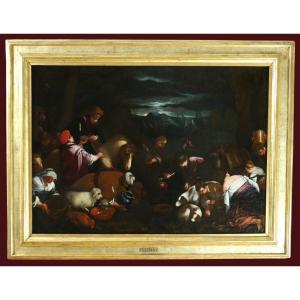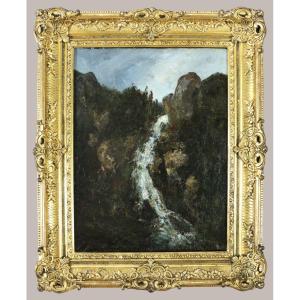Relined canvas measuring 64 cm by 57 cm
Superb Louis XIV style frame measuring 87 cm by 77 cm
Initially considered to be the portrait of the young Louis XIV, our research leads us to believe that this is unlikely. On the other hand, the Grand Dauphin is much more relevant. We know of a first portrait painted by Nocret of the Grand Dauphin at the age of two or three, made in 1663/1664 (museum of the Château de Versailles). In our portrait, the boy is older, certainly around 5/6 years old.
The Grand Dauphin, Louis of France, first son and heir of Louis XIV was born in 1661 and died prematurely in 1711.
Dionysus was a Greek god in his own right. A god whose popularity spanned several eras and who took on different aspects; He is depicted both as a handsome, effeminate youth with thick hair and as a corpulent, bearded adult. Functionally, the Greek Dionysus and the Roman Bacchus are the same god. However, there are some important differences. Dionysus, a noble, youthful figure from mythology and classical literature, is usually included in the list of the twelve Olympian gods. Bacchus, on the other hand, is often depicted as a corpulent, mature man who, according to the Roman poet Ovid, is vengeful and uses his staff as both a magic wand and a weapon against those who dare to oppose his cult and his ideals of freedom.
Jean Nocret (1615, 1672)
He was a student of Jean Le Clerc, a painter from Lorraine. After a trip to Rome where he met Poussin with whom he had a slight falling out, he returned to Paris in 1644. In 1649, he was appointed painter to the King, valet to the King and painter to the Duke of Orléans. He quickly became known and appreciated as a portrait painter. In 1657, Nocret was part of the retinue of the Bishop of Comminges, French ambassador to Portugal. During this period, he painted portraits of the Portuguese royal family (the Infanta Catherien, the Infante Pierre and King Alphonse VI).
Returning to Paris in 1660, he was responsible for decorating certain ceilings and walls of the Château de Saint Cloud and numerous portraits. The best-known painting created at this time is today in Versailles (Louis XIV and his family as gods of Olympus). In 1663, he joined the Royal Academy of Painting and Sculpture. Under the direction of Lebrun, he was tasked with decorating the Palais des Tuileries, notably the ceilings of the antechamber and the Queen's bedroom. All these decorations have of course disappeared and fortunately many portraits have come down to us. For some of them, experts hesitate in their attribution between Nocret and Louis Ferdinand Elle.








































 Le Magazine de PROANTIC
Le Magazine de PROANTIC TRÉSORS Magazine
TRÉSORS Magazine Rivista Artiquariato
Rivista Artiquariato